Want to learn Spanish faster? Spaced repetition apps can help you retain vocabulary and grammar effectively by revisiting material at just the right time. Here's a quick overview of the top apps for mastering Spanish:
- Anki: Highly customizable flashcards with advanced spaced repetition. Free on Android, $25 on iOS.
- Memrise: Combines spaced repetition with videos of native speakers. Costs $60/year or $325 lifetime.
- Brainscape: Uses confidence-based repetition to focus on weak areas. Pricing varies by deck.
- Rocket Spanish: Full-course lessons with integrated review tools. Lifetime access starts at $180.
- Mondly: Gamified learning with AI chat and voice recognition. $12/month or $60/year.
- LingoDeer: Teacher-designed lessons with grammar and vocabulary focus. Starts at $14.99/month.
- Cram: Simple flashcards with spaced repetition. Free with optional premium features.
- Duocards: Create flashcards from videos and articles. Free with premium upgrades.
Quick Comparison
| App | SRS Algorithm | Spanish Content | Cost | Key Features |
|---|---|---|---|---|
| Anki | Advanced, customizable | User-created decks | Free/$25 (iOS) | Full control, multimedia support |
| Memrise | Adaptive algorithm | Native speaker videos | $60/year, $325 lifetime | Fun videos, gamified lessons |
| Brainscape | Confidence-based repetition | Expert-curated decks | Varies | Progress tracking, collaboration |
| Rocket Spanish | Integrated into full course | Comprehensive lessons | ~$180 lifetime | Cultural insights, interactive tools |
| Mondly | Gamified adaptive algorithm | Practical vocabulary | $12/month, $60/year | AI chatbot, AR/VR features |
| LingoDeer | Structured, theme-based | Grammar-focused lessons | $14.99/month | Grammar tips, offline access |
| Cram | Basic spaced repetition | Pre-made and custom decks | Free/premium options | Simple interface, study games |
| Duocards | 6-interval system | Flashcards from videos/articles | Free/premium upgrades | AI tools, multimedia flashcards |
Pro Tip: Try free trials to see which app fits your learning style. Pair these tools with Spanish media and conversations for the best results. Ready to start? Dive into the details of each app below!
How Spaced Repetition Helps You Learn Spanish Words Faster
1. Anki
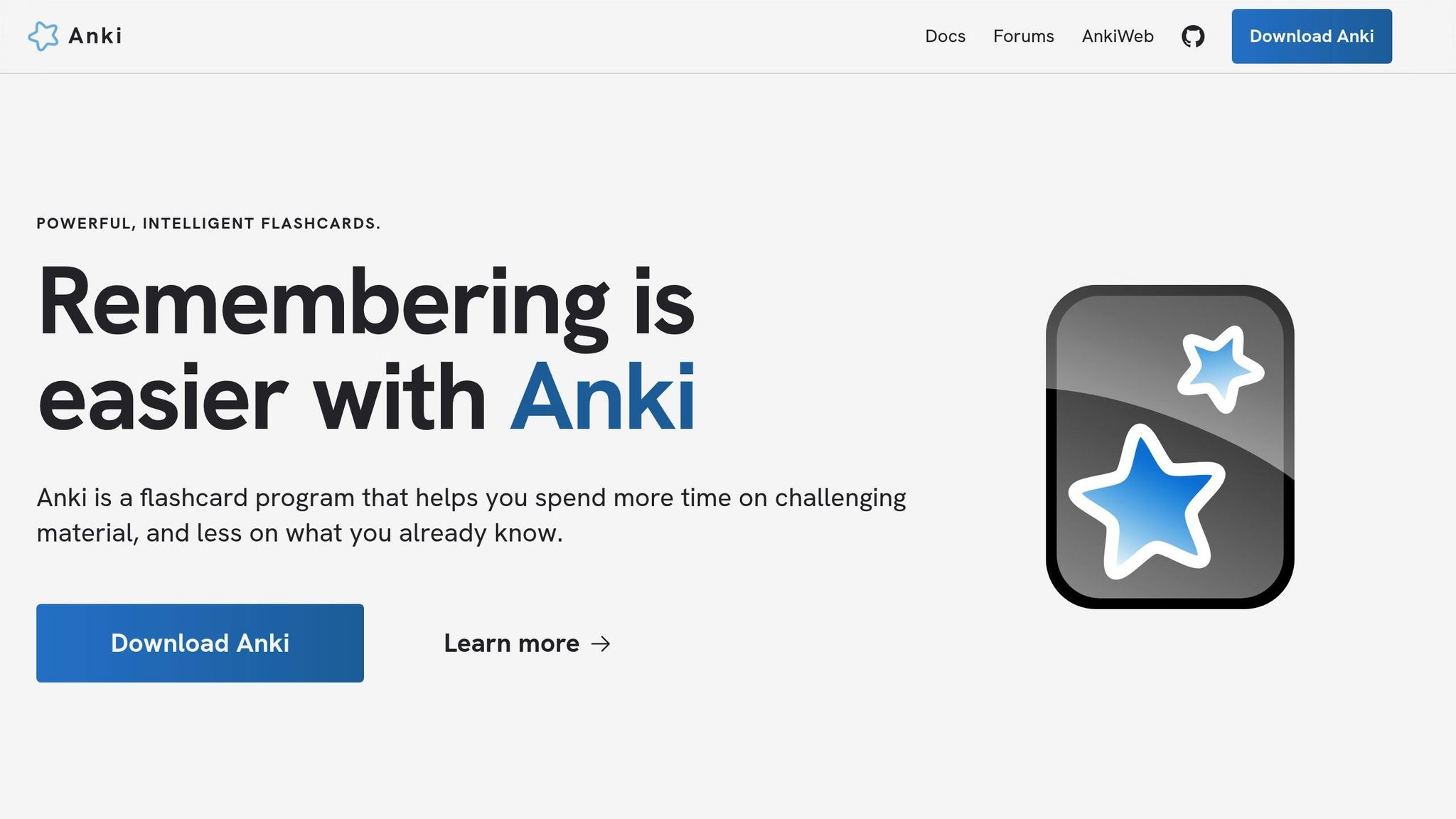
Anki is a standout tool for Spanish learners, offering a free (except on iOS) flashcard-based platform powered by a highly effective spaced repetition system. Its flexibility and customization options make it a favorite among language enthusiasts.
How the Spaced Repetition Algorithm Works
Anki's spaced repetition algorithm is backed by research and is designed to help learners retain vocabulary over the long term. By showing material at carefully timed intervals, it strengthens memory retention [3].
Studies highlight Anki's impact on language learning. For instance, research from Arcadia University found a strong link between Anki usage and improved Spanish performance:
"The results showed a positive relationship between days studying with Anki and Spanish performance at the end of the semester even while controlling for baseline abilities and for motivation, self-efficacy, and beliefs." [3]
Similarly, a 2017 study reported significant vocabulary gains among learners using Anki, and research from Iowa State University and Usak University confirmed that integrating Anki into vocabulary learning boosted retention rates [3].
The app's feedback system simplifies the review process with three options - Again, Good, and Easy. These responses determine when a card reappears, ensuring that difficult words are reviewed more frequently and easier ones at longer intervals [5]. This system ensures learners focus on what they need most.
Spanish-Specific Decks and Resources
Anki isn't just a general flashcard app - it offers decks tailored specifically for Spanish learners. From basic grammar and vocabulary to specialized topics like medical terminology, AnkiWeb hosts a wide range of free decks [6]. However, the quality of these decks can vary, so it’s worth exploring to find the best fit.
Some decks, like the Language Atlas Spanish Anki Decks, are particularly well-regarded. These decks include 14,000 flashcards covering both European and Latin American Spanish, complete with audio pronunciations and IPA notation for clarity [7]. A user, Richard Moore from the UK, shared his experience:
"This has been the most effective method for me to learn Spanish. I began with almost no Spanish knowledge and now I find myself being able to understand it! I think the Spanish audio really helps. I already look forward to trying the Spanish A2 Anki Deck!" [7]
Popular deck categories include frequency-based vocabulary decks, conjugation-focused resources like the "Ultimate Spanish Conjugation (Lisardo's KOFI Method)" deck, and sentence-based decks that teach grammar in context [6].
Customization and Platform Compatibility
Anki shines when it comes to customization and accessibility. It’s available on multiple platforms, including Windows, Mac, Android (free), iOS (paid), and through AnkiWeb for syncing across devices [4][6].
The app allows users to create flashcards that include text, images, and audio, tailoring them to individual learning needs [4]. You can also adjust review settings - like daily card limits and intervals - to fit your schedule. For Spanish learners, starting with just 10 cards and dedicating 20–30 minutes a day can lead to steady progress [4].
While pre-made decks save time, creating your own decks can target specific vocabulary gaps or personal interests. This level of control makes Anki a powerful tool for tackling individual challenges in Spanish learning.
2. Memrise
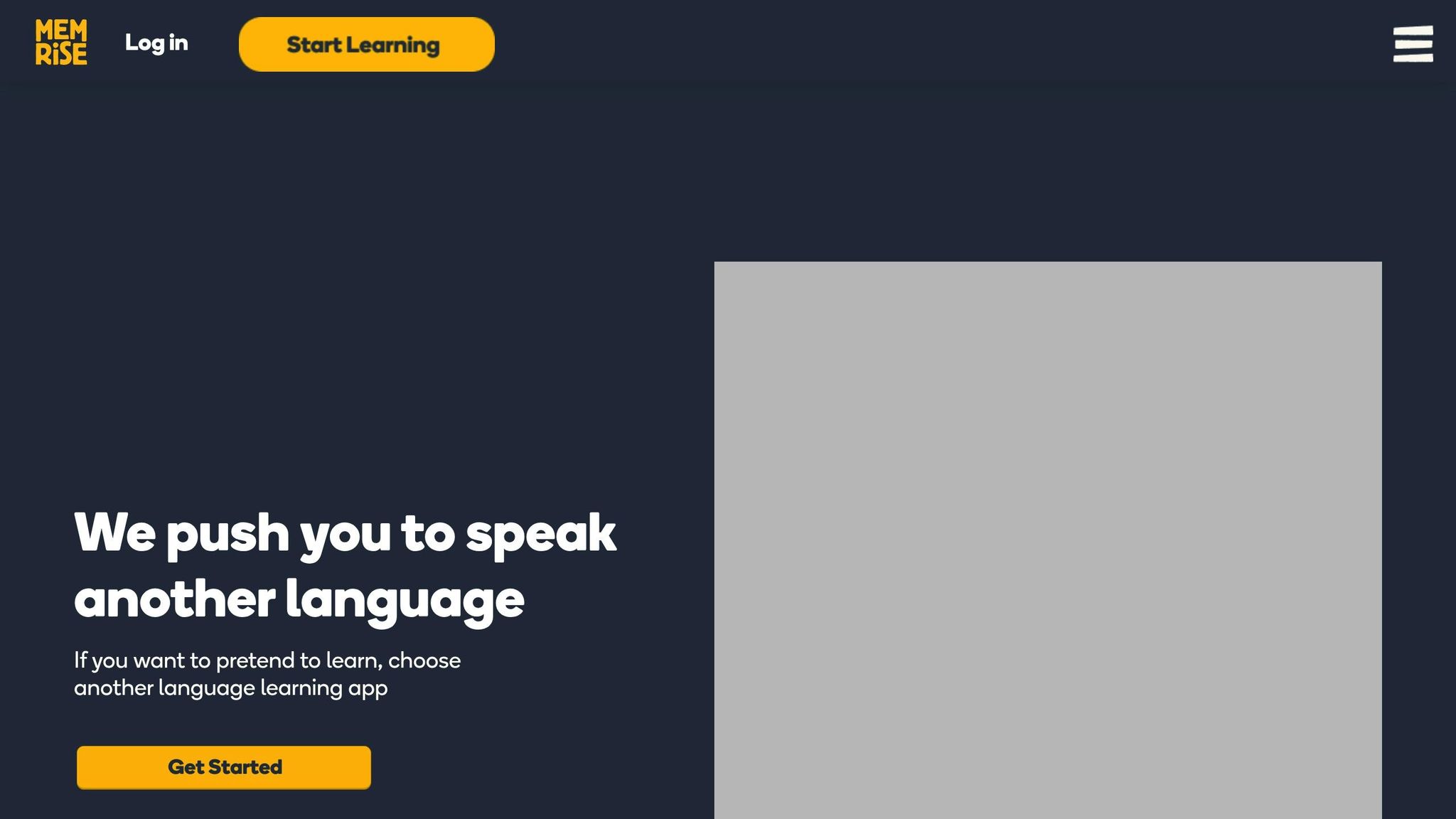
Memrise blends spaced repetition techniques with multimedia tools to make learning Spanish engaging and effective. With a user base of over 65 million people worldwide, it’s a proven platform for mastering Spanish vocabulary and grammar using science-backed methods [12].
How Spaced Repetition Works on Memrise
Memrise’s spaced repetition system (SRS) focuses on tracking words that learners find difficult and scheduling them for more frequent reviews. The platform is built around research-based insights into how we learn:
"Memrise is based on several important scientific discoveries about how we learn... Secondly, Memrise makes use of Spaced Repetition, helping you review words at expertly spaced intervals to help you maintain them in memory in the most efficient manner possible." – Memrise [10]
Studies back up the effectiveness of this approach. One study revealed that just three minutes of daily SRS practice allowed English as a Foreign Language (EFL) students to retain vocabulary three times better over the long term [8]. This method is especially helpful for Spanish learners aiming to reach B2 proficiency on the CEFR scale, which typically requires a vocabulary of around 4,000 words [9]. Memrise’s strong foundation in learning science is matched by its rich Spanish-specific content.
Spanish-Focused Courses and Features
Memrise offers extensive Spanish courses designed by expert linguists, covering both European Spanish and Latin American Spanish [12]. These courses include:
- Over 1,400 lessons
- 9,000+ native word pronunciations
- 1,000+ immersion videos
- 75+ AI-driven conversations for real-world practice [13]
What makes Memrise stand out is its emphasis on real-world usage. The app incorporates content inspired by popular culture, such as clips from Blue Beetle and Puss in Boots, as well as practical topics like the Top 5,000 Words and GCSE exam preparation [13].
One user shared their experience with the app’s approach:
"I've learned more in 2 months on this app than I learned of Spanish in my 4 years of high school." – idahoe.potatoe [12]
Engaging Tools to Keep You Motivated
Memrise keeps the learning process fun and interactive with a variety of tools. The app uses gamification and an AI language partner to help users practice speaking and listening [15]. The "Immerse" feature offers short, TikTok-style videos that make listening and reading comprehension both enjoyable and easy to fit into your day [16]. Additionally, community-created "mems" (mnemonics) provide creative ways to remember words and phrases [15].
These features are designed to complement Memrise’s flexible lesson formats, making it accessible to learners with different styles and preferences.
Adaptable Learning on Any Platform
Memrise offers personalized Spanish lessons that cater to a variety of learning styles [12][13]. The platform includes both official courses and user-created content, allowing learners to explore specialized topics or alternative teaching methods [14]. With daily goal-setting and mobile app compatibility, it’s easy to integrate Spanish practice into even the busiest schedules [15].
While Memrise is a powerful tool, it works best when paired with other resources like grammar guides or Spanish-language media [11]. This combination ensures a well-rounded learning experience.
3. Brainscape
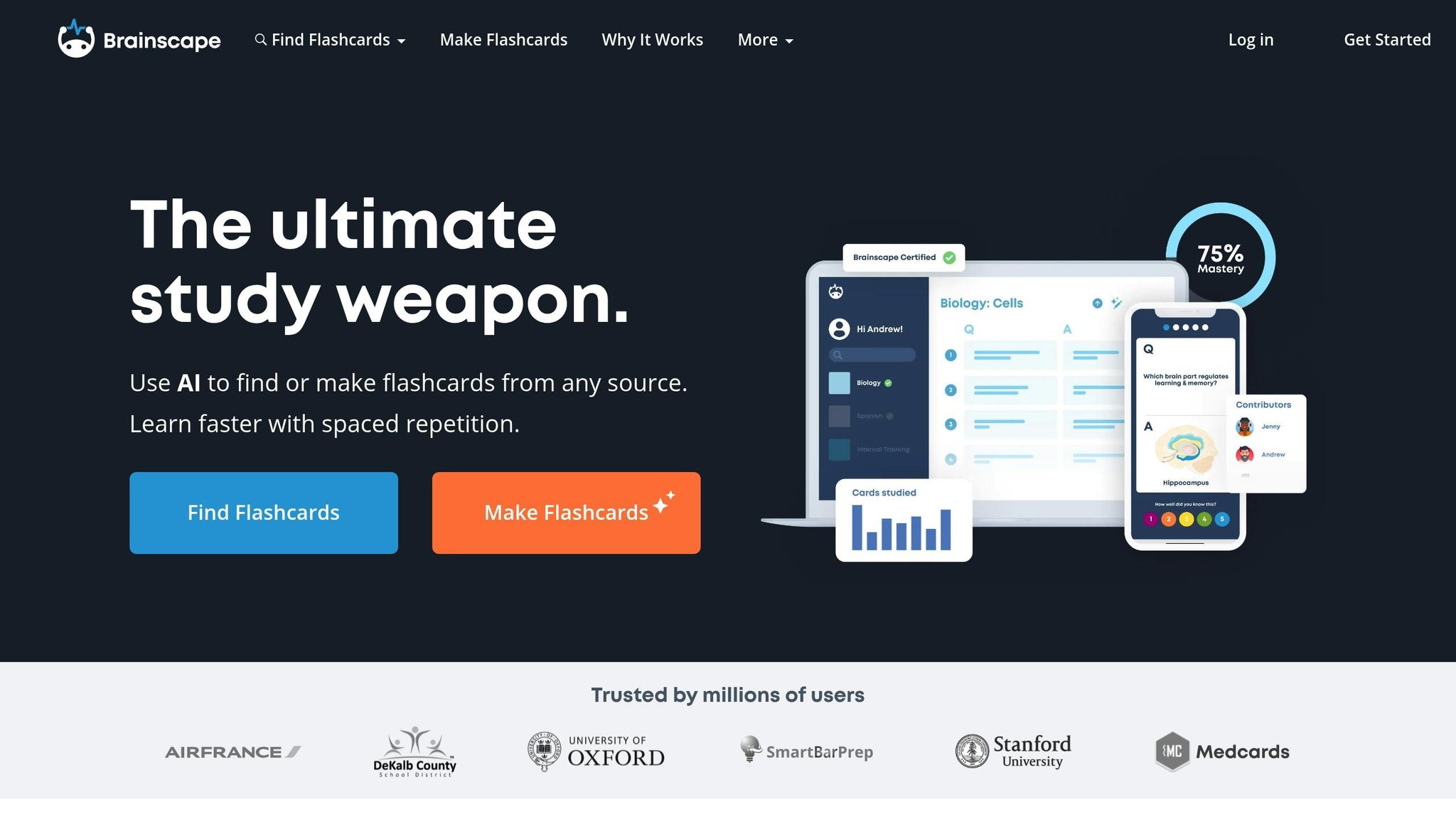
Brainscape combines spaced repetition with metacognition through its Confidence-Based Repetition (CBR) system. With over 1 million users learning Spanish and French, it’s a trusted platform for building vocabulary effectively [18].
How the Spaced Repetition Algorithm Works
Brainscape’s algorithm tailors review intervals based on how confident users feel about each flashcard. Using a 1–5 self-rating scale, the system prioritizes cards you find challenging, showing them more frequently, while cards you’ve mastered appear less often [19].
This method isn’t just theory - it’s backed by research. A study from Columbia University revealed that students who used Brainscape for just 30 minutes scored twice as high on post-tests compared to those using traditional books or paper flashcards [17]. The improvement is linked to Brainscape’s Intelligent Cumulative Exposure (ICE) approach, which builds concepts progressively and incorporates multiple forms of exposure [18]. This structured methodology ensures a personalized and efficient path to mastering Spanish.
Features That Enhance Engagement
Brainscape offers tools to make Spanish learning interactive and memorable. You can upload unlimited images and sounds to your flashcards, creating stronger visual and auditory connections to vocabulary [17]. Plus, the platform allows you to copy and customize flashcards created by others, tailoring your study materials to fit your specific needs [17].
Accessibility and Device Compatibility
Brainscape stands out for its flexibility and ease of use across devices. Whether your goal is conversational Spanish, business terminology, or exam prep, you can create custom flashcards that align with your objectives [20]. The app is mobile-friendly, letting you practice Spanish wherever you are [20]. Your progress syncs seamlessly across web and mobile platforms, whether you’re using a desktop, Android, or iPhone [17]. However, an internet connection is required to keep your progress updated [20].
Interestingly, Brainscape’s CEO originally designed the system to learn Spanish himself [18]. This origin story speaks to the platform’s dedication to breaking down language barriers effectively.
4. Rocket Spanish
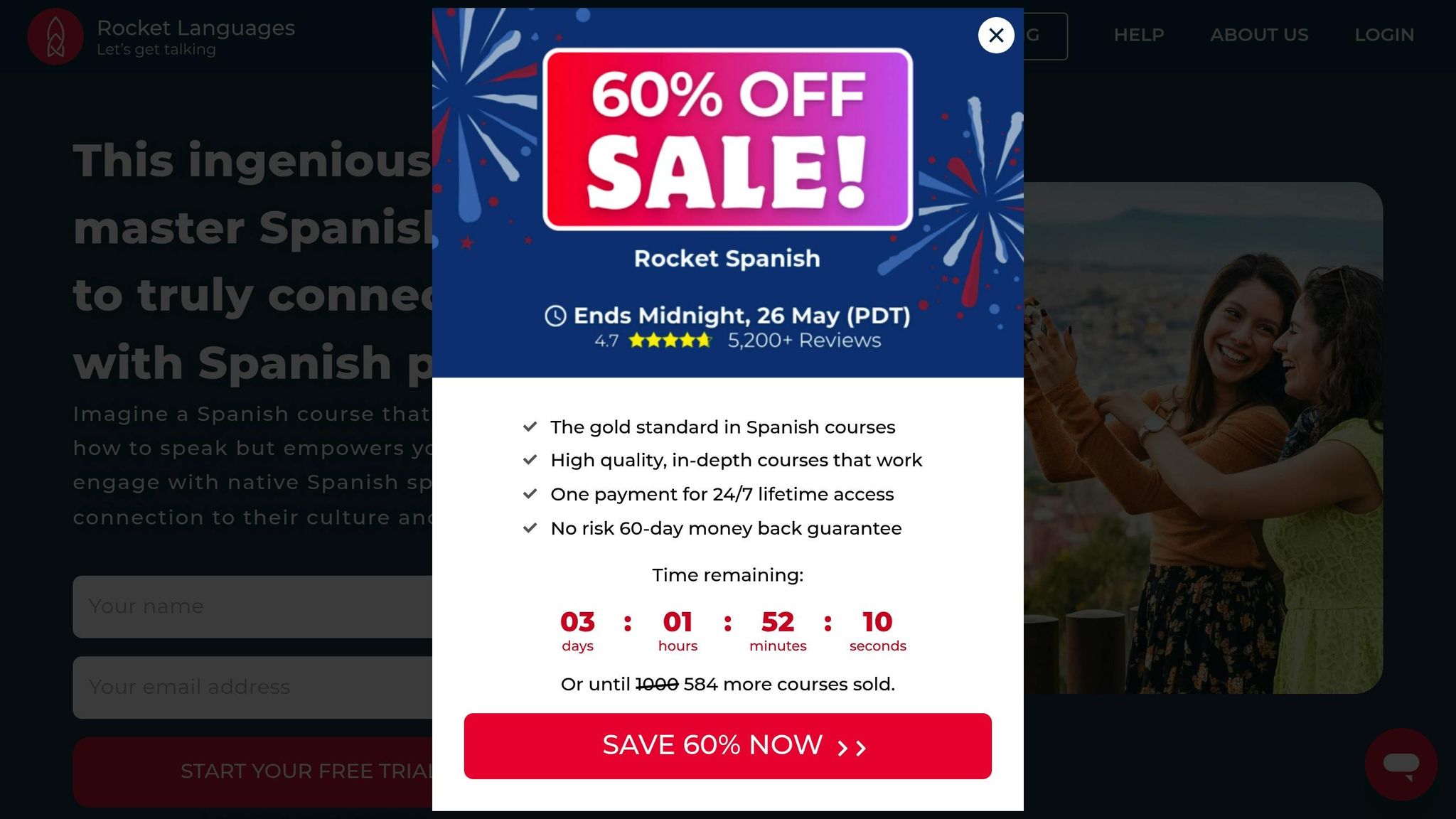
Rocket Spanish takes a different approach to language learning by focusing on full-course lessons rather than relying on traditional spaced repetition techniques. With a 4.7-star rating from over 5,000 reviews [22] and a 4.5/5 rating on the App Store [25], it’s clear that learners have a positive experience with this platform. Let’s dive into how Rocket Spanish caters specifically to Latin American Spanish learners with its tailored lessons in vocabulary and grammar.
Spanish-Specific Content (Vocabulary, Grammar)
This course is designed with Latin American Spanish in mind, emphasizing practical vocabulary and grammar through interactive audio and cultural lessons. The curriculum is broken into three main types of lessons: interactive audio, language and culture, and Survival Kit lessons. The language and culture lessons simplify grammar concepts while weaving in cultural elements, like everyday customs, historical events, and regional practices [23].
"Rocket Languages is essential for anyone who is serious about learning a new language. The course is designed to help us start having real life conversations from the very first lesson. Instead of wasting time learning useless vocabulary, Rocket Languages teaches words and phrases that we are likely to use to everyday." – Mohit B, USA [22]
Interactive and Engaging Features
Even though Rocket Spanish doesn’t use traditional spaced repetition, it keeps learners engaged with features like game-like exercises, self-graded flashcards, and its voice recognition tool, Rocket Record. This tool, powered by Google’s speech recognition technology, evaluates pronunciation and includes 2,666 voice comparison phrases [24][26]. To make the learning process fun and rewarding, the app includes points, badges, and streaks to keep users motivated [24].
Flexibility and Pricing
Rocket Spanish combines its engaging content with flexible pricing options. Level 1 costs $149.95, Levels 1 & 2 are priced at $299.90, and all three levels together come to $449.85 [23]. The platform allows learners to move through lessons at their own pace without requiring complete mastery of one section before advancing [24]. Additionally, frequent promotions make the courses more affordable [21]. Many users praise Rocket Spanish for going beyond simple vocabulary drills by offering in-depth explanations of word usage and cultural context, which helps learners understand how to apply the language in real-life situations [25].
"This course is the best I have used in decades of language learning, utilising the various input needed to get the language into long-term memory. Grammar is learned for the most part through context/immersion, making it relevant and very useful. I thoroughly recommend Rocket - it works!" – Chris M, UK [22]
5. Mondly
Mondly takes a playful approach to learning Spanish, earning a solid 4.7/5 rating on the UK App Store with over 5,800 reviews and 4.5/5 on Google Play Store, backed by an impressive 879,000 reviews [30]. By blending spaced repetition techniques with technology, Mondly creates an engaging experience that moves beyond basic vocabulary drills.
How Spaced Repetition Boosts Retention
Mondly’s "review function" is built around spaced repetition, a proven method for improving memory retention [27]. At the end of each lesson, the app provides a quick recap of the vocabulary you’ve just learned, helping to lock it into your memory [28]. Additionally, its "brain feature" allows users to revisit related words and phrases in context, making the learning process even more effective [28]. Through a mix of flashcards, listening exercises, and speed reviews, Mondly ensures that new words stick [29]. Lessons are short - just 5 to 15 minutes - encouraging daily practice, which is key to retaining what you’ve learned [27]. Beyond its clever algorithm, Mondly also offers a wealth of Spanish content to explore.
Spanish Content: Vocabulary and Grammar
Mondly provides a well-rounded Spanish curriculum as part of its suite of 41+ language options, covering 50 topics tailored to expand grammar and vocabulary [30]. With 41 conversations set in real-world scenarios, the app teaches practical, everyday Spanish using recordings from native speakers [30]. The lessons are designed to suit learners at all levels - beginners can build a strong foundation, while advanced users can refine their skills [31]. By incorporating dialogues, practical examples, and contextual learning, Mondly helps users apply their knowledge in real-life situations [31].
"Mondly is like having a private tutor" - CNN [32]
Immersive and Interactive Features
Mondly takes learning up a notch with its virtual reality (VR) and augmented reality (AR) features. The VR app, available for a one-time cost of $5, places users in lifelike scenarios, such as shopping at a grocery store [27]. Meanwhile, the AR app - free with a premium account - introduces a CGI teacher and interactive animations into your environment for a more immersive experience [27]. A chatbot mimics real conversations to help improve speaking skills [33], while speech recognition technology gives instant feedback on pronunciation using natural voices [34]. To keep learners engaged, Mondly also offers daily lessons, quizzes, and challenges [33].
Flexible and Convenient Learning
Mondly is designed with flexibility in mind. With over 1,000 language combinations and 33 native language options to choose from, it caters to a wide range of learners [30]. The premium plan is priced at about $10 per month or $48 annually, with occasional lifetime access deals for around $90 [27]. Its short lessons are perfect for those with busy schedules, focusing on practical vocabulary that’s useful in everyday life [27]. Plus, Mondly works across multiple devices, ensuring you can learn wherever you are - whether at home or on the go.
"The new way to learn languages" - Inc. [32]
sbb-itb-dfae180
6. LingoDeer

LingoDeer stands out with its teacher-designed curriculum and structured approach to grammar. With over 20 million learners globally and a 4.8-star rating on the App Store from more than 25,000 reviews[38][39], it has earned a reputation for effectively teaching Spanish using spaced repetition techniques.
How Spaced Repetition Works
The app’s review system strengthens your grasp of vocabulary and grammar by using spaced repetition. This method strategically revisits material over time, breaking down complex topics into smaller, digestible pieces for easier learning and better retention[36]. Lessons are carefully crafted by professional language teachers to maximize learning outcomes[36][37].
Tailored Spanish Content
LingoDeer offers over 200 lessons that cover grammar and vocabulary, taking learners up to an intermediate level[38]. Courses focus on practical topics like Food & Drinks, Questions, and Numbers[35]. For instance, the Food & Drinks lesson teaches the correct use of "un" and "una" and how to conjugate key verbs like comer (to eat) and beber (to drink)[35]. Learners can choose between Castilian and Latin American Spanish, and helpful Learning Tips summarize essential grammar rules. Additionally, the Alphabet section provides a solid base for mastering Spanish pronunciation[35].
Interactive Features to Keep You Engaged
LingoDeer enhances its structured lessons with interactive tools. You can use the pronunciation feature to record your voice and compare it to native speakers[40]. The app also includes a "Fluent" mode to build conversational skills and a "Test Out" feature for skipping ahead - though you’ll need to pass with fewer than three mistakes to ensure mastery[36][39][35].
Convenience and Accessibility
Designed to fit into any schedule, LingoDeer allows you to download lessons for offline use, making it perfect for studying on the go[35]. The app is available on iOS, Android, and through its website. Subscriptions start at $14.99 per month, with a lifetime access option priced at $159.99[36][39]. To stay on track, users can set daily learning goals and reminders[41]. Many learners also recommend combining LingoDeer with conversation apps like HelloTalk to practice speaking once they’ve built a strong grammar foundation[37].
7. Cram
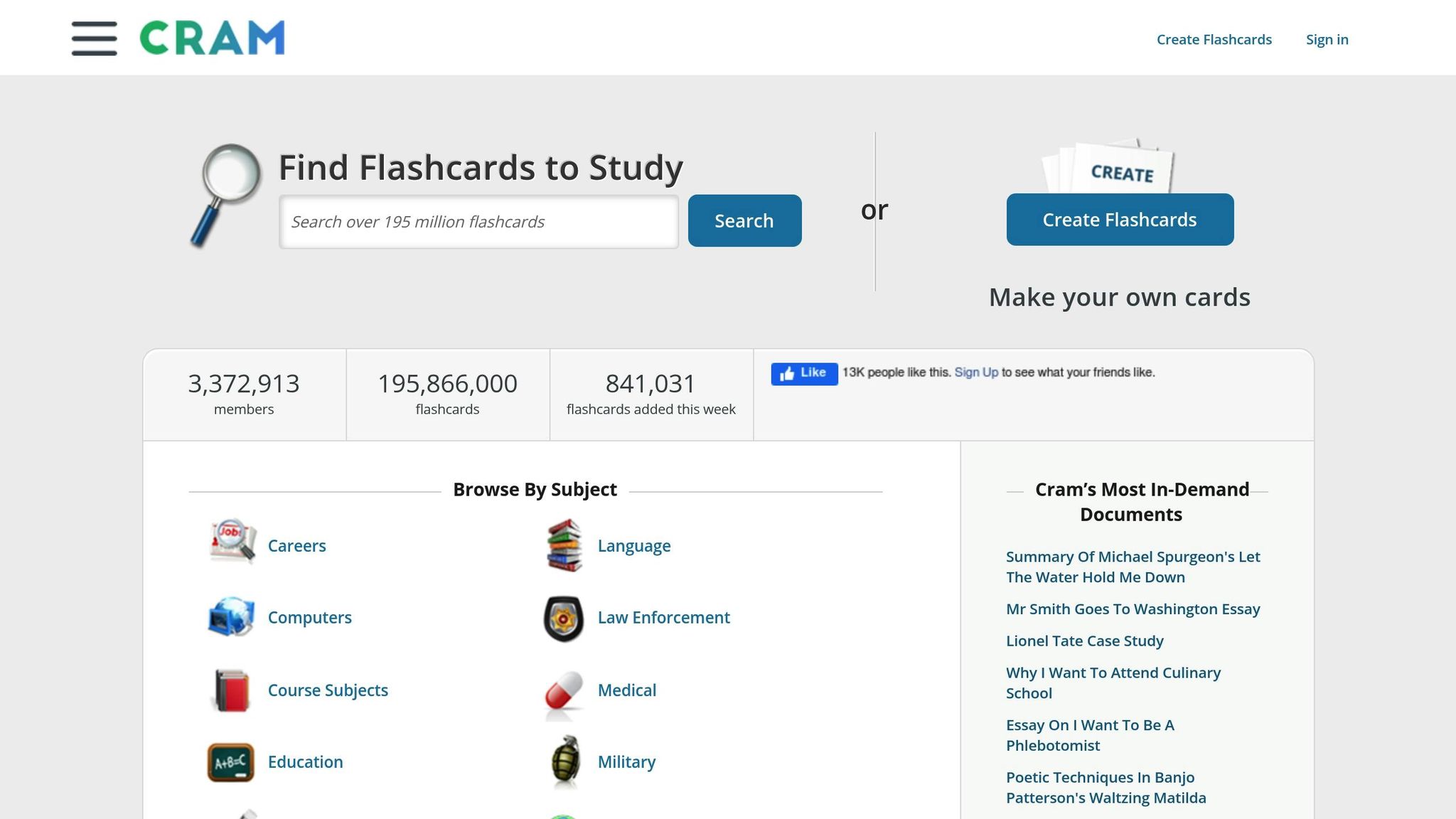
Cram offers a simple and effective spaced repetition system, making it a great choice for learners focused on building Spanish vocabulary. The platform boasts over 195,866,000 flashcards [43], with a wealth of Spanish-specific content available.
How Cram's Spaced Repetition Works
Cram combines traditional flashcards with a spaced repetition system designed to help you master small sets of vocabulary before moving on to new material [19]. The app's algorithm schedules reviews based on your progress, ensuring you retain what you've learned. Its "Cram Mode" is perfect for intensive review sessions, reinforcing knowledge through repeated practice [19]. Flashcard decks are organized into categories like self-created, favorites, and frequently studied sets, giving you quick access to the materials you use most [42].
Spanish-Focused Content
Cram shines when it comes to Spanish-specific resources. It offers a variety of pre-made flashcard sets, such as "Spanish Irregular Verbs" and "Spanish 302 Chapter 9", catering to diverse learning needs [43]. If these don’t match your goals, you can create custom flashcards to focus on particular topics, like regional expressions or dialects [42][43]. This flexibility makes it an excellent tool for personalized vocabulary building.
Features That Keep Learning Fun
Cram isn’t just about algorithms - it also includes interactive features to make studying more enjoyable. It offers multiple study modes, such as traditional review, dynamic memorization, and engaging game options, all designed to improve retention [42]. A Spanish text-to-speech feature is also available, which helps you nail pronunciation [45].
Accessibility and Usability
Cram works across Android, iOS, and web platforms, with a user-friendly interface that adapts to mobile devices. It even supports offline access, so you can study anytime, anywhere [44]. Most of its features are free, but if you want an ad-free experience or advanced formatting tools, you can opt for a monthly subscription. Multimedia integration is another perk, allowing you to enhance your flashcards with images or audio [19].
While the interface might feel a bit clunky at times, Cram still holds a 3.7/5 rating on the Amazon Appstore, based on 69 reviews [46]. With its flexibility, interactive features, and multimedia support, Cram earns its spot as a solid option for Spanish learners.
8. Duocards
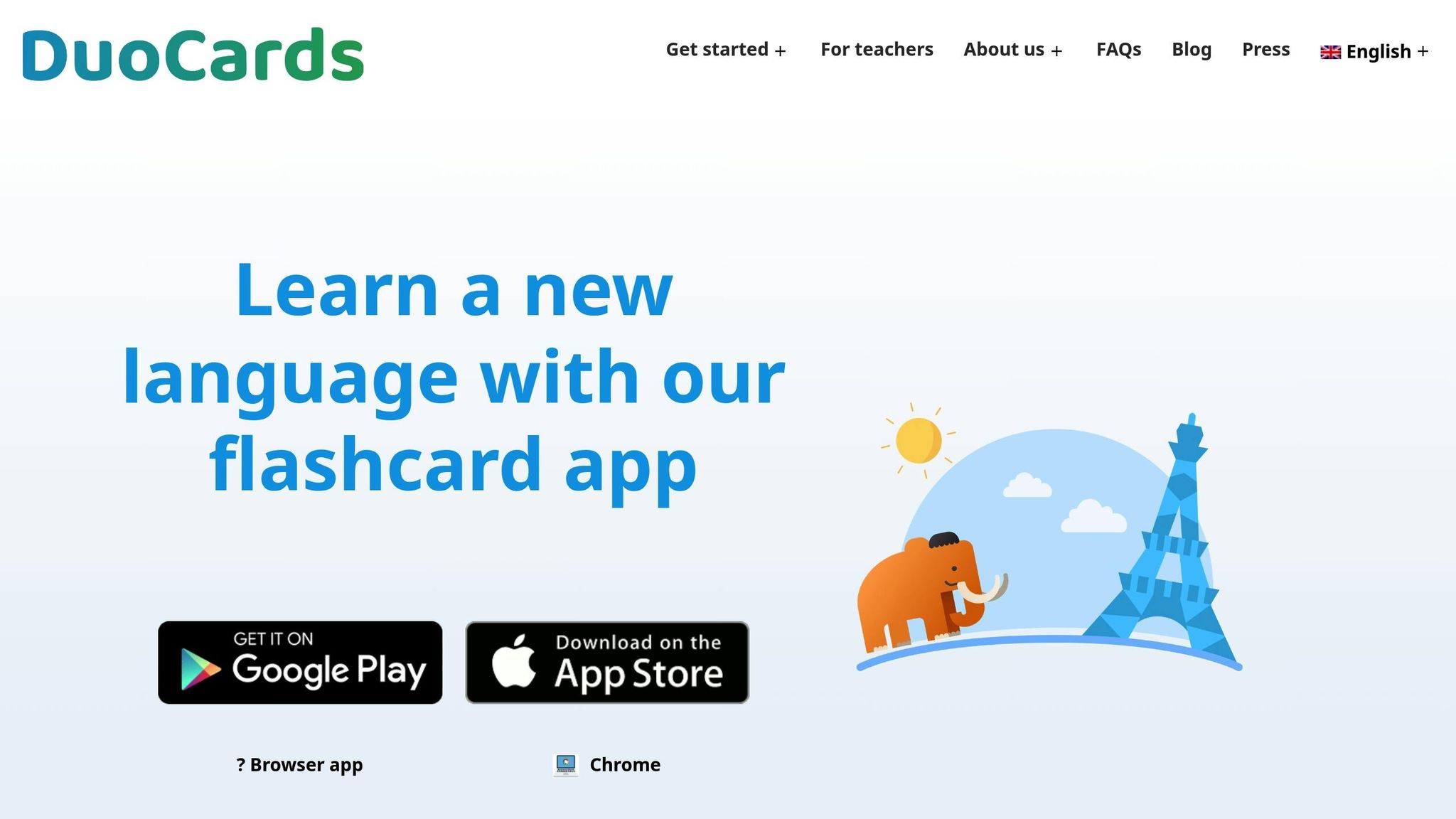
Wrapping up our list, Duocards blends spaced repetition with multimedia tools to create a dynamic language-learning experience. With a 4.8/5 rating on both Google Play and the App Store [48], it’s one of the top-rated apps for mastering Spanish vocabulary.
Spaced Repetition Algorithm That Works
Duocards employs a spaced repetition system designed to adapt to your learning pace [19]. The intervals - 90 seconds, 30 minutes, 12 hours, 2 days, 2 weeks, and 2 months - are carefully structured to reinforce vocabulary retention. The system includes extra repetitions before extending intervals, ensuring thorough learning. Listening tests add another layer by helping you practice from both directions [49]. While not as advanced as Anki’s algorithm, many users find it highly effective for long-term memory. Lisa, a satisfied user, shared her experience:
"The app is probably the most useful on the market right now, it has an algorithm that is really working for me..." [48]
Content Designed for Spanish Learners
Duocards offers a treasure trove of Spanish learning resources, including flashcards, YouTube videos, and articles sorted by difficulty [47]. You can either create your own custom flashcards or explore pre-made decks on a variety of Spanish topics [75, 79, 80]. The app supports learning in 50+ foreign languages, with Spanish being one of its most comprehensive offerings [79, 80]. A built-in translator lets you turn words into flashcards instantly [75, 79, 80]. You can also add images to your cards for better recall and access community-generated thematic vocabulary sets [75, 76]. Plus, its AI-powered chat feature offers an interactive way to practice conversational Spanish [47].
Engaging and Interactive Features
One standout feature is the ability to create flashcards directly from Spanish videos and articles. Simply highlight or double-click words and phrases to add them to your study deck [51]. The app provides different review methods, such as translating from your native language to Spanish and matching words with their meanings [47]. Teachers particularly value its collaborative tools. Chris, a language teacher, shared:
"It's a fun and easy-to-use app that allows me to share vocabulary lists, articles, and videos with my students. The ease of use means that students are able to find materials more closely matching their own interests, further developing their self-study skills" [50]
Convenient and Customizable
Duocards offers flexibility to suit various learning preferences. It’s available on Android, iOS, and web browsers, with a Chrome extension for added convenience [51]. This cross-platform access ensures you can study Spanish anytime, anywhere. The app also allows users to tailor their learning experience by creating flashcards from real-life conversations, articles, and videos [51]. Educators can design custom decks for their students, making it ideal for both personal and classroom use [50].
While the app has many strengths, a few drawbacks have been noted. In March 2025, Lindsey Ellefson from Lifehacker rated it 3.5/5, praising its spaced repetition and gamification features but mentioning occasional lag and the cost of premium features [52].
App Feature Comparison
After diving into detailed reviews, let’s break down the key differences between popular Spanish spaced repetition apps. This comparison is designed to help you choose the right app based on your goals, budget, and preferred learning approach. Below is a clear feature breakdown of eight leading options:
| App | SRS Algorithm | Spanish-Specific Content | Cost | Key Additional Features |
|---|---|---|---|---|
| Anki | Highly customizable, complex algorithm | User-generated Spanish decks available | Free (Android), $25 one-time (iOS) | Full customization, multimedia cards, cross-platform sync |
| Memrise | Adaptive algorithm with user-created content | Substantial free Spanish content | $60/month, $100/year, $325 lifetime | Community-created courses, video clips featuring native speakers |
| Brainscape | Confidence-based repetition system | Curated Spanish decks prepared by experts | Varies by deck creator | Collaborative study tools and progress tracking |
| Rocket Spanish | Integrated SRS within a comprehensive course | Comprehensive Spanish curriculum with cultural lessons | ~$180 lifetime (after discounts) | Audio course, pronunciation tools, rich cultural context |
| Mondly | Adaptive algorithm enhanced with gamification | Focused Spanish proficiency content | $12/month or $60/year | AI chatbot, voice recognition, hands-free learning features |
| LingoDeer | Theme-based structured algorithm | Interactive lessons developed by language teachers | Varies | Clear audio quality and detailed grammar explanations |
| Cram | Basic spaced repetition system | User-generated Spanish flashcard sets | Free with premium options | Simple interface, study games, mobile accessibility |
| Duocards | 6-interval system (ranging from 90 seconds to 2 months) | Offers Spanish among content for 50+ languages | Premium features available at extra cost | Video-to-flashcard creation, AI chat, multimedia support |
Key Insights
-
Spaced Repetition Systems (SRS): Apps like Anki stand out for their advanced, customizable algorithms, while simpler options like Cram rely on basic repetition cycles. Memrise and Mondly use adaptive systems to tailor learning experiences.
-
Spanish Content Quality: If you’re looking for curated and detailed lessons, Rocket Spanish and LingoDeer shine with their structured, teacher-developed material. On the flip side, apps like Anki and Memrise rely on user-generated decks, which can be hit or miss. A 2019 study highlights that high-quality pre-made decks can significantly enhance learning outcomes.
-
Pricing: Costs vary widely. Anki is free for Android users, with a one-time $25 fee for iOS. Subscription-based apps like Mondly charge $12/month or $60/year, while Rocket Spanish offers lifetime access for around $180 after discounts.
-
Engagement Features: Interactive tools like AI chatbots (Mondly, Duocards) and gamified elements (Mondly) add a fun twist to learning. Meanwhile, Anki focuses on straightforward repetition and offers full offline functionality, a perk often reserved for premium tiers in other apps.
-
Ease of Use: Anki’s customization options come with a steeper learning curve, making it ideal for tech-savvy users willing to invest time in setup. In contrast, apps like Memrise and Mondly are user-friendly and ready to go with minimal effort.
Each app has its strengths, so your choice will depend on what matters most to you - be it cost, content depth, interactivity, or ease of use.
Conclusion
Spaced repetition is a game-changer for anyone committed to mastering Spanish. Research published in Educational Psychology Review shows that this method can boost long-term retention by up to 200% compared to cramming, even with the same amount of study time [2]. By countering Ebbinghaus's forgetting curve, spaced repetition helps transform short-term knowledge into lasting memory [1][2].
The apps we've discussed leverage this method in unique ways to cater to different learning preferences. Whether you opt for Anki's deep customization, Mondly's AI-driven chatbot, or Rocket Spanish's rich context for Spanish language and culture, the key is to choose an app that aligns with your goals and keeps you engaged. As Shawn Loewen, a language learning expert from Michigan State University, advises:
"One problem is that these apps are easy to put down. That's why you need to find one that you like, that is engaging to you, and that you will actually come back to" [53].
To truly excel, combine these apps with other learning techniques. Watching Spanish-language movies, reading articles, or practicing conversations can reinforce what you’ve learned. Spaced repetition works best when you focus on manageable chunks of material, allowing the algorithm to handle the rest over time.
Each app offers distinct advantages, from the free and versatile Anki to the all-encompassing Rocket Spanish. Take advantage of free trials to explore which one fits your needs. Incorporating spaced repetition into your routine can make a noticeable difference in your Spanish skills, helping you achieve your language-learning goals.
FAQs
Spaced repetition is a powerful tool for mastering Spanish vocabulary and grammar. By leveraging the brain's natural learning rhythms, this method involves reviewing material at specific intervals - right before you're likely to forget it. This timing reinforces your memory, helping you retain information for the long haul. Plus, it prioritizes the concepts you find most challenging, so you're not wasting time revisiting things you already know well.
Unlike cramming, which often results in quickly forgotten knowledge, spaced repetition spreads learning out over time. This makes your study sessions not only more effective but also more efficient. The result? You save time while gaining a deeper grasp of the language.
When picking a spaced repetition app to learn Spanish, there are a few things to keep in mind to make sure it works for you. Start with customization - choose an app that lets you tweak review schedules, focus on specific vocabulary themes, or align lessons with your personal goals. Next, consider the user-friendly design. An app with a simple, intuitive layout makes it much easier to stay motivated and navigate without frustration. Lastly, check that the app uses a smart algorithm that adapts to your progress. This ensures you're reviewing words or phrases right before they slip from memory, boosting how well you retain them. These features can make all the difference in your Spanish learning experience.
Spaced repetition apps are powerful tools for learning Spanish, particularly when it comes to expanding your vocabulary and reinforcing grammar. These apps use smart algorithms to show you information at just the right intervals, making it much easier to retain what you've learned compared to basic memorization techniques.
That said, they work best when paired with more traditional learning methods. In-person or live classes offer unique benefits like real-time feedback, conversational practice, and deeper cultural exposure - things apps simply can’t provide. To get the most out of your learning journey, blend the strengths of both approaches for a more complete and effective experience.

